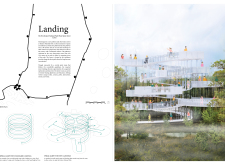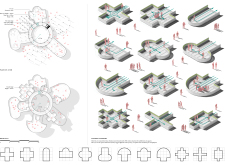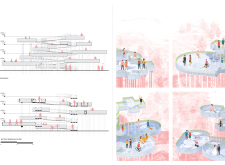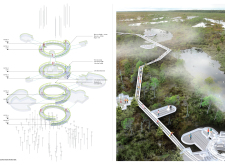5 key facts about this project
# Architectural Design Analysis Report: "Landing" Observation Tower at Kemeri National Park, Latvia
## Overview
Located within Kemeri National Park in Latvia, the "Landing" observation tower and pathway project aims to enhance visitor engagement with the natural landscape. The design prioritizes accessibility and immersion, facilitating a direct connection between users and the park’s unique ecological features. The concept reflects a commitment to integrating architectural elements within the existing environment, encouraging visitors to engage meaningfully with their surroundings.
## Spatial Configuration and User Interaction
The observation tower features a central spiral ramp that adheres to accessibility guidelines, promoting an inclusive experience for all visitors. This configuration allows for a fluid progression through varying elevations and views, emphasizing diverse perspectives of the park’s bogs and forests. A series of interlocking platforms and balconies creates opportunities for social interaction and contemplation, while the thoughtfully designed pathways lead visitors along unique routes, enhancing their journey through the landscape.
## Material Considerations
Materials were selected for their durability and ecological harmony. Concrete serves as the primary structural support, while steel is utilized in railings to ensure stability without compromising aesthetic appeal. Glass elements allow for transparency and unobstructed views, while wood adds warmth and a tactile connection to the environment. These choices are intended to meet both functional requirements and sustainability goals, maintaining resilience within the natural dynamics of the park.
The design features distinct landing configurations inspired by historical geometric forms, offering varied seating arrangements and spatial experiences that accommodate diverse user needs. Elevated walkways are strategically planned to minimize ground disturbance, affirming the project’s respect for the surrounding ecosystem.





















































